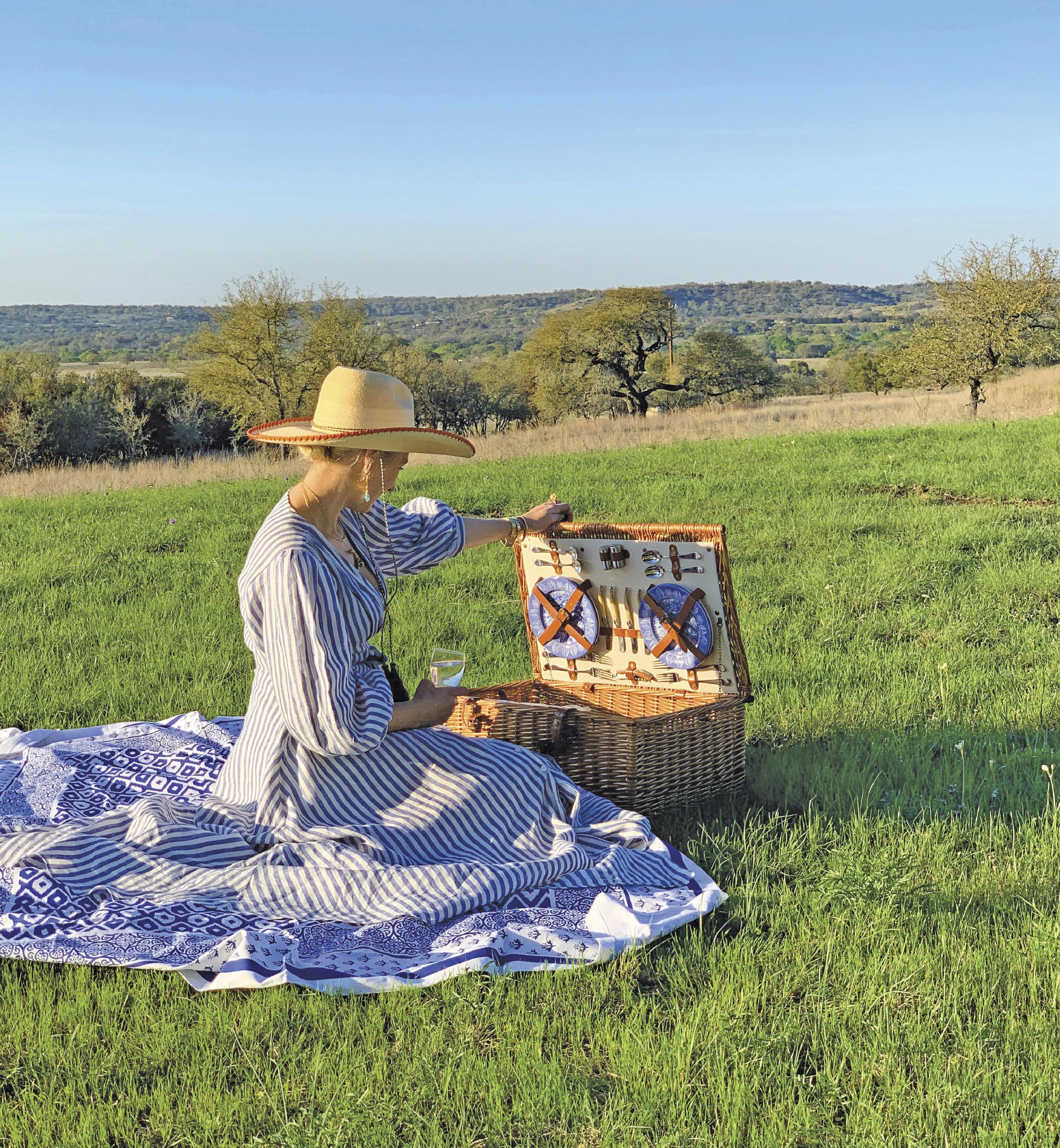
7 minute read
The Ten Commandments of Quarantine
Dinnertime Is Sacred
By Suzanne Pollak
Quarantine highlighted how home life really works, day in, day out, before work, after work, and all day long. We got to see the big picture and the little details, with inhabitants in situ. A major opportunity arose to discover, refocus, experiment, and possibly establish a different path going forward, one that we never dreamt of before March. Aren’t we lucky to make a course correction if we needed one?
Even if it’s only a tiny adjustment, change always starts with something small. It’s the little things that make the biggest impact over a long period of time. Change during COVID starts at home, in our behavior towards the people with whom we share space.
Here are two recent examples I love:
Ask Questions.
As I was leaving the first real dinner party I attended during COVID, my hostess, out of the blue, asked, “What can I do for you?” I was floored, moved, touched. Who asks a question like that for no apparent reason? She made me feel loved and protected, seen and respected. A little question is one way a powerful person goes beyond the surface to make life better for another.
Listen Carefully.
When my teenage granddaughter visited in August, we sat on my bed each night simply talking about where each of us found ourselves in life at that moment. I realized this young lady knows how to listen, actively, with curiosity. She knows that we can’t control how someone else feels, but we can control the effort we make to understand them. What an essential skill to carry throughout life!
These little things happen in rooms, forming the heartbeat of the house. The life that goes on in the kitchen especially impacts everyone’s well-being, and, more importantly, the future life of the inhabitants. With nutrition, manners, and verbal communication, you model ways to be and do and live.
Now kitchens everywhere wear a multitude of hats, serving as home office, playroom, homework station, classroom, living room, winery, even penal colony—enough hats to drive anyone crazy! Are family members gravitating and gathering in the kitchen, wanting to hang out for hours? How do you make that atmosphere happen? It’s possible even when everyone is cooped up.
During the past six months, cooking and dining may be the only good times to step away from doing your day job at home, hovering over your computer or trying to manage your child’s education. Spending an extended period of time together around a table nurtures family relationships and establishes a foundation for lifelong intimacy. The three key words are sit, table, together, as opposed to individuals spread out in different rooms, eating in front of their screens, hiding out in their bedrooms. You must eat together. Period.
As much as we may crave ditching dinner and escaping to a restaurant, today is a different world. Taking a break from screens, meetings, and homework, getting into the kitchen and preparing food means we eat together. Nightly meals are the time for face-to-face human connection more than ever now, even if it’s only with those we see all day long, love the most, and get annoyed with the quickest. Mouths need to be fed! We have a tremendous chance to make little adjustments and strengthen family ties by knitting our family together, one dinner at a time.
I used to make pasta with the children of mine who were interested, and we hung the strips over broomsticks to dry. I found tricks to get three out of four of my children to eat eggplant. I turned into a pyromaniac and turned the lights off to light crèmes brûlées. I showed teenage sons how to grind fifty pounds of venison as I cracked the antique marble table the grinder was screwed on to—anything to get them to hang out with me in my kitchen. The history of my life is in the kitchen. Now it’s a place to teach my grandchildren how to make the world’s best pancakes and how to crack an egg. A place to pass down knowledge. These future generations aren’t pining after my silver. They want love and wisdom. Now is the time to teach.
I worry that if people didn’t grow up experiencing and seeing how to use a house for all its many uses, how could they possibly know? That is the whole reason for the Charleston Academy’s existence. Maybe you need to brush up on your baking and cooking skills so you can pass down something besides your Instagram feed. The future of family dinners is in your hands. It’s what your children will inherit from you too. The family silver, the bank account—all nice. But examples of how to live are much more important.
Dinner is sacred.
Let’s keep it that way. If you are a parent, dinner used to be the time for prime intel gathering, when children returned from school and sports. It’s still that time, even though your children may be home all day long. Dinner is not the place for dishing out discipline. Kids will learn to dislike family dinners, the mainstay of family life, where problems can be solved but also created. A dreadful dinner hour will have a lasting effect in the future.
Attitudes matter.
Yours is infectious. Make daily cooking a happy habit instead of a chore. It’s not drudgery and a nuisance. It’s something that will be passed on just like your furniture will be, in memories pleasant or punishing, affecting how future lives are lived.
Make quickie meals.
Who decided that twenty minutes is the Holy Grail timing for preparing dinner? These days we want to get something cooking in two minutes, not twenty. Sometimes I make seven-minute meals: sausage supper, seafood stew, tuna and pasta, omelets. Not a big commitment, but supersatisfying. Try them! (Email Suzanne@CharlestonAcademy.com for a Zoom tutorial.)
Think creatively when feeding teenagers.
Recently, my future daughter-in-law looked at me with astonished eyes and asked, “Did you know that your son eats a whole roast chicken at dinner?” Ha! Did I know! Who fed that guy when he was a teenager, a nonstop eating machine? One of the joys of being a mother who has graduated from feeding a flock of ravenous teenagers is the feeling of relief. Sometimes, to fill their bottomless stomachs, I would add sautéed small potatoes to a pot of stew and then ladle that over buttered noodles just so I wouldn’t have to serve a second dinner two hours later. Carbs to the rescue! Satisfying and filling mood enhancers. Doesn’t every teenager need this?
Carbs are perfectly healthy when you make them yourself. For a chance to perfect your baking skills, take the Fall 2020 Carbs 101 class at the Academy. Gain a lifetime of useful recipes to carry you through your time with teenagers and beyond.
Change noneaters into eaters.
Does your household have youngsters whose appetites are like those of epiphytes in a humid hothouse, and you feel lucky if a few tablespoons of stew occasionally get past their lips and gums, even by accident? You might have pulled out all your hair by now. Solution? Give in. Make what they want but think of ways to expand their growing brains. Go about the food problem from another angle. Give them pots to plant with radishes and peas, or let them stir a stew, flip a steak, and set the table; rename salmon “pink chicken” for toddlers—anything to turn their heads toward the wide, wonderful world of eating.
Make do-ahead meals.
A lifesaver when you are tired or stressed. Spread the labor out over a manageable period of time and cook together. There is nothing better than pulling a zip-lock bag of anything homemade out of the freezer—there it is, ready to eat. I call them MREs, the military term for meals ready to eat. MREs slip into the “Almost like Vacation” category in 2020.
Switch the cooks and the cleaners.
One person does not need to be doing all the heavy lifting. Change the jobs around so everyone appreciates the others’ contributions. One night a week, children twelve years old and up can be put in charge of family meal preparation while the parents tackle cleanup.
Master a few meals.
Once you do something over and over again, like roasting a chicken, your curiosity can take over and send you in a new direction each time.
Conjure past and future trips.
Make a wish list or a “been there, done that” list. Create recipes that remind you of places you have been or want to go. Be creative or serve a nostalgic, seasonally inspired variation.
Suzanne Pollak, a mentor and lecturer in the fields of home, hearth, and hospitality, is the founder and dean of the Charleston Academy of Domestic Pursuits. She is the coauthor of Entertaining for Dummies, The Pat Conroy Cookbook, and The Charleston Academy of Domestic Pursuits: A Handbook of Etiquette with Recipes. Born into a diplomatic family, Pollak was raised in Africa, where her parents hosted multiple parties every week. Her South Carolina homes have been featured in the Wall Street Journal Mansion section and Town & Country magazine. Visit CharlestonAcademy.com or contact her at Suzanne@CharlestonAcademy.com to learn more.










